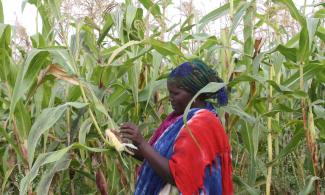
FAO is working with family farmers in Somalia's maize belt to ensure they access to major maize markets and get improved inputs amidst climate change challenges.
In the Lower Shabelle Region of Somalia, maize farming is experiencing a revival as communities are relying on it to fighthunger and improve their livelihoods. In the region’s districts of Afgooye and Awdeghle, in what is considered Somalia’s maize belt, 500 family farms are producing international quality graded maize, and by forming cooperatives, they are selling large quantities at higher prices with more bargaining power.
Since 2013, the Food and Agriculture Organization (FAO), and the Ministry of Agriculture of the Federal Government of Somalia (MoA), have been providing these farmers with inputs, climate-smart agricultural technologies, and training in good agricultural practices like post-harvest management and pest control, and business skills. There have been results. In 2015, they collectively produced over 2000 metric tonnes of maize, an increase from the 200 metric tonnes they produced in 2013.
googletag.cmd.push(function() { googletag.display('content1'); });
FAO has also facilitated training on grains standards and grading, provided by the Eastern African Grain Council in Kenya. “Maize grain quality has improved from the lowest grade 4, up to 1 and 2,” said Jan Helsen, the Agriculture Sector Coordinator, FAO Somalia.
As a result, these farmers now have access to new and lucrative markets, like the World Food Programme (WFP) which buys their maize to use for their relief programme in the country. According to Haji Mayow of the National Association for Agricultural Cooperative (NAAC)in Somalia, most of these farmers were displaced by war and relocated to the capital Mogadishu, but went back to their farms, when FAO and the MoA, offered to support them revive their agricultural activities.
Through funding by the European Union, these farmers have been supported with tractors to cultivate land, inputs like fertilizers, pest control technologies, and quality seeds. That has enabled them increase their yields from 0.8 to 2 tonnes per hectare. Through post harvest practices trainings they are also handling their grains properly, to prevent incidences of aflatoxin contamination common in East Africa. Farmers from the two districts have also been organized in 10 cooperatives each with 50 members. To these cooperatives, FAO has provided them with tarpaulins for drying grains, grain moisture meters and weighing scales.
googletag.cmd.push(function() { googletag.display('content2'); });
With increased yields and improved handling of maize grains, farmers are collectively bulking their grains at their cooperatives into quantities sufficient to meet WFP’s demands. For each 100 kilogram bag of maize, WFP buys at about $43. “We have been encouraged by the market price from WFP,” said Mayow. Consequently, household incomes for the 500 family farmers increased by 50 percent, according to Mayow.
With increased incomes from maize, poor families are now sending their children to school. According to Abdurazak Ali, a farmer, only two of his five children could attend school four years ago, but today, he affords to have all of them enrolled.
The positive ripple effect of this project is being felt around the country, as other farmers are organizing themselves into cooperatives, according to Ali who also works in the planning department of NAAC. “Everything is changing we are very happy,” said Ali.
Increased incomes have also made farmers optimistic about the future, and some are increasing the size of land they are cultivating from one hectare to five hectares, according, to Mayow. “Families who used to have one meal a day are able to get two to three meals a day, and build better houses,”he said.
Still, there are production challenges. According to the UN’s Office for the Coordination of Humanitarian Affairs (OCHA) 2014 data, Somali farmers only meet 40 percent of the country’s cereal demand. Also droughts along the horn of Africa are common. To counter these challenges, Somalia farmers are being trained on climate smart farming, to ensure they are resilient when droughts occur.
According to Helsen, going through wars for years has caused agriculture to lag behind in Somalia, as farming is largely done traditionally with little returns. As a result, farming communities are still vulnerable, and are not able to adapt to changes in climate patterns. From April to June and October to December 2016, poor rains, resulted in 1.1 million Somalis, facing acute food insecurity, according to Famine Early Warning Systems Network.
To increase farmers’ adaptation to climate change, FAO is providing them with climate smart seed, and pumps to irrigate their farms. Farmers are also being trained on conservation of irrigation water, sustainable agriculture intensification, and agro-silvo pastoral practices, to increase carbon capture. Drought resilient crops like cassava whose leaves and by products, serve as livestock feed are also being gradually adopted by these farmers. Duringthe short rains of October to December; farmers are also growing fast maturing cereals like sesame, and cowpeas.
Success will depend on market demands as this will wean farmers from donor based interventions during emergencies, according to Helsen. “Market forces will determine what farmers produce,” he said. According to Abdi Ahmed Mohammed of the National Resilience Focal Point Somalia, agriculture is a conduit by which resilience can be built at the grassroots, to prevent costly aftershocks of droughts like malnutrition and famine.
googletag.cmd.push(function() { googletag.display('comments'); });